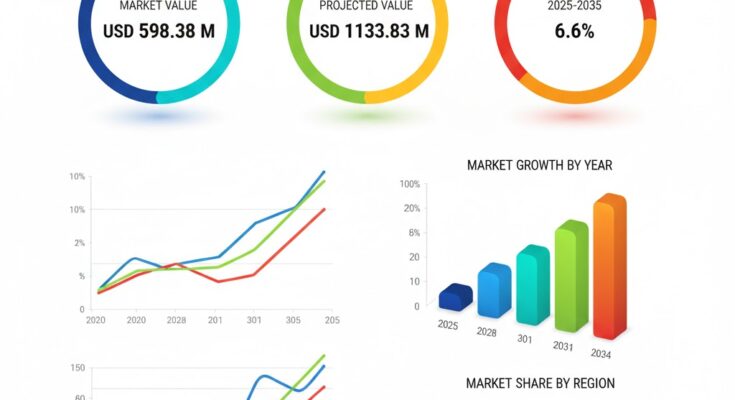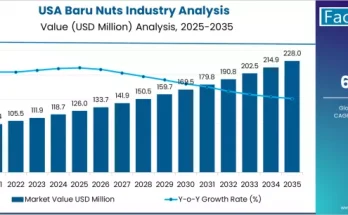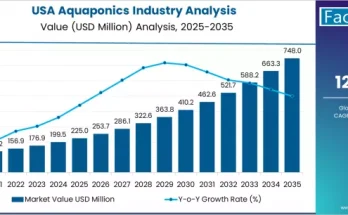The global mulching heads market is poised for robust growth over the next decade, driven by escalating demand across forestry, agriculture, utility, and urban land-management sectors. According to a recent market intelligence report, the market is projected to climb from USD 598.38 million in 2025 to USD 1,133.83 million by 2035, growing at a compound annual growth rate (CAGR) of 6.6%.
This growth is being fueled by rising infrastructure activity, government-led wildfire mitigation initiatives, expanding conservation agriculture, and a growing preference for low-impact vegetation management attachments.
Growth Drivers & Market Momentum
-
Land-Clearing and Wildfire Mitigation: Governments globally are ramping up wildfire suppression efforts and funding right-of-way maintenance, creating strong demand for high-flow hydraulic mulching heads. These attachments are being increasingly procured by forestry departments, utilities, and rental firms.
-
Eco-Forestry & Reforestation: Conservation agriculture, reforestation, and urban greening programs are boosting demand for lightweight, low-noise mulching equipment, particularly in regions emphasizing sustainable land management.
-
Automation & Electrification: Automation technologies, including LiDAR-guided navigation, remote operation, and hybrid-drive systems, are becoming standard in modern mulching heads. These innovations enhance safety, efficiency, and precision in challenging environments.
-
OEM Partnerships: Equipment manufacturers are forming strategic alliances with mulcher OEMs to integrate advanced mulching heads into forestry machinery, compact utility vehicles, and track loaders, driving broader adoption.
Market Segmentation & Key Trends
The report divides the market into key segments, shedding light on where and how demand is concentrated.
-
Drive Type:
-
Direct Drive systems are leading the market. Their design offers higher mechanical efficiency, better torque, and lower maintenance compared to belt-driven alternatives—making them especially appealing for rugged forestry and land-clearing applications.
-
-
Carrier Capacity:
-
The 20–30 ton carrier capacity segment is the most commercially attractive. It balances power and maneuverability, making it ideal for forestry operations, infrastructure maintenance, and pipeline corridor clearing.
-
-
Mounting Equipment Capacity (HP):
-
Equipment in the 100–200 HP range is expected to see the highest uptake. These units are compatible with a variety of platforms—skid steers, compact track loaders, and tractors—and are favored for mid-scale, versatile vegetation tasks.
-
-
Max. Shredding Diameter:
-
Mulching heads that handle 25–40 cm shredding diameters are projected to grow fastest. This range is optimal for both dense forestry and right-of-way maintenance applications where cutting efficiency and flexibility matter.
-
-
Cutting Width:
-
Units with a cutting width of 48–56 inches are becoming increasingly popular. They maximize productivity without losing maneuverability, particularly in utility maintenance, highway clearing, and site-prep applications.
-
-
Mounting Equipment Types:
-
Compact track loaders emerge as the most favored platforms, thanks to their stability, ground-pressure advantages, and suitability for sensitive terrain areas such as wetlands, slopes, or ecologically fragile zones.
-
Regional Insights
-
North America: Leading the pack, the U.S. is seeing heightened investment in smart mulching machines driven by wildfire risk, labor shortages, and urban vegetation mandates. The push for quieter, electric, or hybrid-inspired units is particularly strong.
-
Europe: Countries such as Germany, France, and the UK are adopting low-emission, remote-controlled mulchers to meet growing urban forestry and land-restoration regulations.
-
Asia-Pacific: This region is emerging as a high-growth frontier. Nations like China, India, and South Korea are expanding rural infrastructure, investing in reforestation, and modernizing land-management fleets with automated, electric-compatible attachments.
Challenges & Market Risks
-
Cost of Automation: The high upfront cost of LiDAR systems, remote-control interfaces, and hybrid powertrains may hinder adoption, particularly among cost-sensitive contractors.
-
Regulatory Compliance: As governments tighten emissions and noise regulations, manufacturers will need to invest in eco-compliant designs, which may raise production complexity and cost.
-
Supply Chain Constraints: Volatility in raw materials, especially for hybrid components, could pressure margins and limit production scaling for next-generation mulchers.
Seasonal Demand: The business is highly seasonal, with peak demand in fire-prone or dry seasons. This fluctuation can disrupt revenue flows and production planning.
Competitive Landscape
Several established global players dominate the mulching heads industry, while regional manufacturers are growing their presence through specialization and innovation. Key companies include:
-
FAE Group — A leader in hybrid and electric mulching technologies and smart attachments.
-
Fecon / Vermeer — Strong presence in high-flow hydraulics and forestry-grade mulchers in North America.
-
Seppi M. — Known for precision mulchers and compact units, particularly in European forestry operations.
-
Tigercat Industries — Focuses on rugged, high-capacity attachments for heavy forestry and infrastructure clearing.
-
DENIS CIMAF — Specialist in brush cutters and lightweight rotor designs for roadside and utility applications.
Other notable players expanding their footprint include John Deere Forestry, Caterpillar, Loftness Manufacturing, Bobcat, Maschio Gaspardo, and TK Agro Industries.
These companies are investing in remote telemetry, modular designs, and noise-reduction technologies to meet evolving customer needs and regulatory demands.
Strategic Outlook & Future Trends
Over the next decade, the mulching heads market is expected to shift significantly:
-
Intelligent Land Management Tools: Mulching heads will increasingly integrate AI, telematics, and LiDAR navigation to support remote operation, predictive maintenance, and terrain-aware clearing.
-
Sustainable Design: Demand will favor hybrid-drive, low-noise, and electric-driven attachments as environmental regulations and urban green mandates intensify.
-
Modular & Multi-Mount Solutions: OEM partnerships will drive the development of mulching heads that can be mounted on a variety of carriers — from compact track loaders to excavators.
-
Expansion into Emerging Markets: Asia-Pacific, Latin America, and other regions with growing infrastructure and reforestation spending will become key battlegrounds.
Browse Full Report : https://www.factmr.com/report/3964/mulching-heads-market
Quote
“Mulching heads are transforming from simple forestry attachments into intelligent, automated systems,” said a senior analyst covering the market. “Growth over the next decade will be driven by innovation in automation, drive systems, and sustainability — particularly as land-clearing strategies evolve to meet environmental and operational efficiency demands.”
About the Report
The Mulching Heads Market Report provides a detailed analysis of market size, segmentation (by drive type, carrier capacity, mounting equipment, shredding diameter, cutting width), regional trends, competitive landscape, and future growth drivers for 2025–2035.



